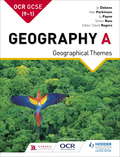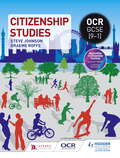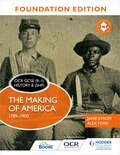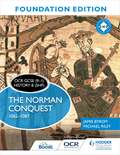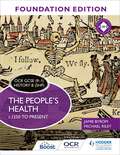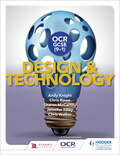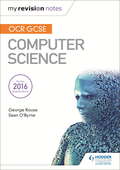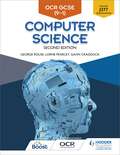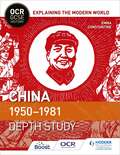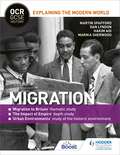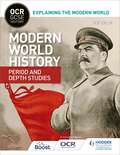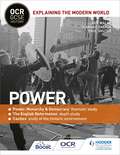- Table View
- List View
OCR GCSE (91) Geography A: Geographical Themes
by Alan Parkinson Jo Payne Jo ColesExam Board: OCRLevel: GCSESubject: GeographyFirst Teaching: September 2016First Exam: June 2018An OCR endorsed textbookInstil a broad understanding of UK and global geographical issues using the clear explanations and skills-focused activities in this thematic study guide; tailored to the new assessment requirements and produced by one of the leading Geography publishers and OCR's Publishing Partner for Geography.- Maps the content against the reformed specification, providing an easy-to-follow teaching pathway designed by an author team of experienced teachers and examiners- Equips students with the subject knowledge and up-to-date case study examples they need to maximise their potential, with opportunities to undertake developmental activities for each theme- Offers you a whole-class solution to teaching the non-tiered papers with extension activities to stretch high achievers and scaffolded questions that support lower-ability students- Embeds a focus on mathematical and statistical skills throughout by including opportunities to analyse a range of maps, graphs, GIS material and data sources- Prepares students to approach assessment confidently with practice questions of varying difficulty and handy tips for writing successful answers- Highlights possible fieldwork projects and contains guidance on carrying out fieldwork, making it easier to integrate practical and theoretical learning
OCR GCSE (9–1) Business, Fourth Edition
by Alan Williams Mike SchofieldWith up-to-date case studies of real-world businesses, this fully updated OCR GCSE (9-1) Business Student Textbook will help your students respond to exam questions with confidence, demonstrating how they can structure their answers for maximum impact. This Student Textbook includes:- Fully up-to-date exam questions, with 25% more practice questions and increased practical support for tackling different question types- More exam tips and advice, with examiner commentary showing how students should approach exam questions- Real-world case studies, new and updated, to reflect the developments in e-commerce and the impact of recent global and political developments- Quick knowledge-recall questions throughout the book to help students check understanding, and for teachers to use in assessment
OCR GCSE (9–1) Business, Fourth Edition
by Alan Williams Mike SchofieldWith up-to-date case studies of real-world businesses, this fully updated OCR GCSE (9-1) Business Student Textbook will help your students respond to exam questions with confidence, demonstrating how they can structure their answers for maximum impact. This Student Textbook includes:- Fully up-to-date exam questions, with 25% more practice questions and increased practical support for tackling different question types- More exam tips and advice, with examiner commentary showing how students should approach exam questions- Real-world case studies, new and updated, to reflect the developments in e-commerce and the impact of recent global and political developments- Quick knowledge-recall questions throughout the book to help students check understanding, and for teachers to use in assessment
OCR GCSE (9–1) Citizenship Studies
by Steve Johnson Graeme RoffeAn OCR endorsed textbook.Association for Citizenship Teaching Quality Mark resource. Encourage students of all abilities to develop an enthusiastic interest in contemporary UK society with knowledge-boosting activities and assessment support for the changed content and assessment criteria; produced by the leading Citizenship publisher and OCR's Publishing Partner.- Equip students with the knowledge and skills they need to fulfil their potential by working through a variety of developmental activities that are suitable for all ability levels- Provide opportunities for students to learn and practise the research, analytical, interpretative and evaluative skills required under the 2016 specification- Bring the key issues and concepts in Citizenship Studies to life using a bank of real-life case studies to enrich students' learning experience- Build students' confidence approaching assessment with targeted assessment preparation, guidance on crafting successful responses and practice questions that include plenty of source analysis tasks- Deliver high-quality lessons that meet the differing needs of your students, following an engaging teaching pathway created by a skilled teacher with extensive examining experience
OCR GCSE (9–1) History B (SHP) Foundation Edition: Living under Nazi Rule 1933–1945
by Jamie Byrom Richard KennettExam board: OCR (Specification B, SHP)Level: GCSE (9-1)Subject: HistoryFirst teaching: September 2016First exams: Summer 2018An OCR endorsed textbook.Help more students access the content for OCR GCSE History B (SHP) with this Foundation Edition, designed to work alongside the mainstream textbook for effective co-teaching in the same class.Covering The Making of America 1789-1900, this book:- Follows the same structure and page numbers as the mainstream textbook so that students of all abilities can explore the same enquiries- Simplifies and reduces the text on each page, using carefully-controlled vocabulary and clear explanations of key terms- Focuses on the key points that students need to understand and includes new content summaries at the end of each enquiry to reinforce learning- Offers full support for the student tasks, using a wide range of scaffolding to make the tasks accessible and achievable- Provides specific assessment guidance and develops the historical thinking skills required for success at GCSEReading level measured and verified by MetaMetrics using the Lexile Framework for Reading
OCR GCSE (9–1) History B (SHP) Foundation Edition: Living under Nazi Rule 1933–1945
by Jamie Byrom Richard KennettExam board: OCR (Specification B, SHP)Level: GCSE (9-1)Subject: HistoryFirst teaching: September 2016First exams: Summer 2018An OCR endorsed textbook.Help more students to access the content for OCR GCSE History B (SHP) with this Foundation Edition, designed to work alongside the mainstream textbook for effective co-teaching in the same class.Covering The Making of America 1789-1900, this book:> Follows the same structure and page numbers as the mainstream textbook so that students of all abilities can explore the same enquiries> Simplifies and reduces the text on each page, using carefully-controlled vocabulary and clear explanations of key terms> Focuses on the key points that students need to understand and includes new content summaries at the end of each enquiry to reinforce learning> Offers full support for the student tasks, using a wide range of scaffolding to make the tasks accessible and achievable> Provides specific assessment guidance and develops the historical thinking skills required for success at GCSE
OCR GCSE (9–1) History B (SHP) Foundation Edition: The Making of America 1789–1900
by Jamie Byrom Alex FordExam board: OCR (Specification B, SHP)Level: GCSE (9-1)Subject: HistoryFirst teaching: September 2016First exams: Summer 2018An OCR endorsed textbook.Help more students access the content for OCR GCSE History B (SHP) with this Foundation Edition, designed to work alongside the mainstream textbook for effective co-teaching in the same class.Covering The Making of America 1789-1900, this book:- Follows the same structure and page numbers as the mainstream textbook so that students of all abilities can explore the same enquiries- Simplifies and reduces the text on each page, using carefully-controlled vocabulary and clear explanations of key terms- Focuses on the key points that students need to understand and includes new content summaries at the end of each enquiry to reinforce learning- Offers full support for the student tasks, using a wide range of scaffolding to make the tasks accessible and achievable- Provides specific assessment guidance and develops the historical thinking skills required for success at GCSEReading level measured and verified by MetaMetrics using the Lexile Framework for Reading
OCR GCSE (9–1) History B (SHP) Foundation Edition: The Making of America 1789–1900
by Jamie Byrom Alex FordExam board: OCR (Specification B, SHP)Level: GCSE (9-1)Subject: HistoryFirst teaching: September 2016First exams: Summer 2018An OCR endorsed textbook.Help more students to access the content for OCR GCSE History B (SHP) with this Foundation Edition, designed to work alongside the mainstream textbook for effective co-teaching in the same class.Covering The Making of America 1789-1900, this book:> Follows the same structure and page numbers as the mainstream textbook so that students of all abilities can explore the same enquiries> Simplifies and reduces the text on each page, using carefully-controlled vocabulary and clear explanations of key terms> Focuses on the key points that students need to understand and includes new content summaries at the end of each enquiry to reinforce learning> Offers full support for the student tasks, using a wide range of scaffolding to make the tasks accessible and achievable> Provides specific assessment guidance and develops the historical thinking skills required for success at GCSE
OCR GCSE (9–1) History B (SHP) Foundation Edition: The Norman Conquest 1065–1087
by Michael Riley Jamie ByromExam board: OCR (Specification B, SHP)Level: GCSE (9-1)Subject: HistoryFirst teaching: September 2016First exams: Summer 2018An OCR endorsed textbook.Help more students access the content for OCR GCSE History B (SHP) with this Foundation Edition, designed to work alongside the mainstream textbook for effective co-teaching in the same class.Covering The Making of America 1789-1900, this book:- Follows the same structure and page numbers as the mainstream textbook so that students of all abilities can explore the same enquiries- Simplifies and reduces the text on each page, using carefully-controlled vocabulary and clear explanations of key terms- Focuses on the key points that students need to understand and includes new content summaries at the end of each enquiry to reinforce learning- Offers full support for the student tasks, using a wide range of scaffolding to make the tasks accessible and achievable- Provides specific assessment guidance and develops the historical thinking skills required for success at GCSEReading level measured and verified by MetaMetrics using the Lexile Framework for Reading
OCR GCSE (9–1) History B (SHP) Foundation Edition: The Norman Conquest 1065–1087
by Michael Riley Jamie ByromExam board: OCR (Specification B, SHP)Level: GCSE (9-1)Subject: HistoryFirst teaching: September 2016First exams: Summer 2018An OCR endorsed textbook.Help more students to access the content for OCR GCSE History B (SHP) with this Foundation Edition, designed to work alongside the mainstream textbook for effective co-teaching in the same class.Covering The Making of America 1789-1900, this book:> Follows the same structure and page numbers as the mainstream textbook so that students of all abilities can explore the same enquiries> Simplifies and reduces the text on each page, using carefully-controlled vocabulary and clear explanations of key terms> Focuses on the key points that students need to understand and includes new content summaries at the end of each enquiry to reinforce learning> Offers full support for the student tasks, using a wide range of scaffolding to make the tasks accessible and achievable> Provides specific assessment guidance and develops the historical thinking skills required for success at GCSE
OCR GCSE (9–1) History B (SHP) Foundation Edition: The People's Health c.1250 to present
by Michael Riley Jamie ByromExam board: OCR (Specification B, SHP)Level: GCSE (9-1)Subject: HistoryFirst teaching: September 2016First exams: Summer 2018An OCR endorsed textbook.Help more students access the content for OCR GCSE History B (SHP) with this Foundation Edition, designed to work alongside the mainstream textbook for effective co-teaching in the same class.Covering The People's Health c.1250 to present, this book:- Follows the same structure and page numbers as the mainstream textbook so that students of all abilities can explore the same enquiries- Simplifies and reduces the text on each page, using carefully-controlled vocabulary and clear explanations of key terms- Focuses on the key points that students need to understand and includes new content summaries at the end of each enquiry to reinforce learning- Offers full support for the student tasks, using a wide range of scaffolding to make the tasks accessible and achievable- Provides specific assessment guidance and develops the historical thinking skills required for success at GCSE
OCR GCSE (9–1) History B (SHP) Foundation Edition: The People's Health c.1250 to present
by Michael Riley Jamie ByromExam board: OCR (Specification B, SHP)Level: GCSE (9-1)Subject: HistoryFirst teaching: September 2016First exams: Summer 2018An OCR endorsed textbook.Help more students to access the content for OCR GCSE History B (SHP) with this Foundation Edition, designed to work alongside the mainstream textbook for effective co-teaching in the same class.Covering The People's Health c.1250 to present, this book:> Follows the same structure and page numbers as the mainstream textbook so that students of all abilities can explore the same enquiries> Simplifies and reduces the text on each page, using carefully-controlled vocabulary and clear explanations of key terms> Focuses on the key points that students need to understand and includes new content summaries at the end of each enquiry to reinforce learning> Offers full support for the student tasks, using a wide range of scaffolding to make the tasks accessible and achievable> Provides specific assessment guidance and develops the historical thinking skills required for success at GCSE
OCR GCSE (OCR GCSE (9-1) Design and Technology)
by Chris Walker Chris Rowe Andy Knight Sharon McCarthy Jennifer TilleyExam Board: OCRLevel: GCSESubject: Design & TechnologyFirst Teaching: September 2017First Exam: June 2019Explore, create, evaluate: help your students to develop an understanding of the iterative design process and to be critical and innovative designers, while developing the knowledge and skills they need for the 2017 OCR GCSE D&T specification. Confidently navigate both the core and in-depth principles of design and technology, including less familiar materials and system components, to ensure your students have the knowledge and understanding they need.· Builds a toolkit of knowledge, understanding and design development skills for the chosen materials or systems, with dedicated chapters covering each of the main categories of materials· Develops mathematical and scientific skills with practice questions that apply this learning in context· Supports the Non-Exam Assessment with guidance on how to approach the Iterative Design Challenge, which includes imaginative and creative examples of student projects to inspire and engage· Helps students to prepare for the written assessment with practice questions covering both the 'core' and 'in-depth' content
OCR GCSE Computer Science My Revision Notes 2e
by George RouseManage your own revision with step-by-step support from experienced teachers and examiners Sean O'Byrne and George Rouse. Use specific case studies to improve your knowledge of Computer Science. Apply terms accurately with the help of definitions and key words.-Plan and pace your revision with the revision planner-Use the expert tips to clarify key points-Avoid making typical mistakes with key expert advice-Test yourself with end-of-topic questions and answers and tick off each topic as you complete it-Get exam ready with last minute quick quizzes at www.hoddereducation.co.uk/myrevisionnotes
OCR GCSE Computer Science, Second Edition
by George Rouse Ian Paget Gavin Craddock Lorne PearceyWritten by leading Computer Science teachers, this brand-new textbook will guide students through the updated OCR GCSE Computer Science specification topic by topic, and provide them with standalone recap and review sections, worked examples and clear explanations of complex topics.This Student Book:>> develops computational thinking skills in line with the new Practical Programming element of Component 02>> provides differentiated material with the 'beyond the spec' feature>> includes standalone recap and review sections at the end of each chapter>> includes answers to the Knowledge Check questions to support independent learning>> provides definitions of technical terms, along with a glossary of words that will be needed for assessment.Looking for answers for the Student Book? They can be found at the back of the print textbook.You can now access a free set of practice questions on the Hodder Education website. Please note, these questions are not endorsed by OCR and have not been subject to any OCR quality assurance processes.George Rouse, Lorne Pearcey and Gavin Craddock are highly respected and widely published authors of resources.
OCR GCSE Computer Science, Second Edition
by George Rouse Ian Paget Gavin Craddock Lorne PearceyWritten by leading Computer Science teachers, this brand-new textbook will guide students through the updated OCR GCSE Computer Science specification topic by topic, and provide them with standalone recap and review sections, worked examples and clear explanations of complex topics.This Student Book:>> develops computational thinking skills in line with the new Practical Programming element of Component 02>> provides differentiated material with the 'beyond the spec' feature>> includes standalone recap and review sections at the end of each chapter>> includes answers to the Knowledge Check questions to support independent learning>> provides definitions of technical terms, along with a glossary of words that will be needed for assessment.Looking for answers for the Student Book? They can be found at the back of the print textbook.You can now access a free set of practice questions on the Hodder Education website. Please note, these questions are not endorsed by OCR and have not been subject to any OCR quality assurance processes.George Rouse, Lorne Pearcey and Gavin Craddock are highly respected and widely published authors of resources.
OCR GCSE Food Preparation and Nutrition
by Val FehnersExam Board: OCRLevel: GCSESubject: Food Preparation & NutritionFirst Teaching: September 2016First Exam: June 2018Endorsed for OCR.Develop your students' knowledge and understanding of food and nutrition, improve their practical food preparation and cooking skills and prepare them for assessment with this book for the 2016 OCR Food Preparation and Nutrition GCSE.- Explains all food and nutrition concepts clearly, including simple definitions of key words- Helps students to apply their knowledge and understanding with engaging practical activities throughout, including photographs to illustrate all of the key techniques- Differentiates with stretch and challenge activities to ensure progression and to challenge more able learners- Prepares students for assessment with clear guidance on the Food Investigation and Food Preparation assessments, as well as advice and practice questions to help them prepare for the written exam
OCR GCSE Food Preparation and Nutrition
by Val FehnersExam Board: OCRLevel: GCSESubject: Food Preparation & NutritionFirst Teaching: September 2016First Exam: June 2018Endorsed for OCR.Develop your students' knowledge and understanding of food and nutrition, improve their practical food preparation and cooking skills and prepare them for assessment with this book for the 2016 OCR Food Preparation and Nutrition GCSE. - Explains all food and nutrition concepts clearly, including simple definitions of key words- Helps students to apply their knowledge and understanding with engaging practical activities throughout, including photographs to illustrate all of the key techniques- Differentiates with stretch and challenge activities to ensure progression and to challenge more able learners- Prepares students for assessment with clear guidance on the Food Investigation and Food Preparation assessments, as well as advice and practice questions to help them prepare for the written exam
OCR GCSE History Explaining the Modern World: China 1950-1981
by Emma ConstantineAn OCR endorsed textbookTrust Ben Walsh to guide you through the new specification and motivate your students to excel with his trademark mix of engaging narrative and fascinating contemporary sources; brought to you by the market-leading History publisher and OCR's Publishing Partner for History.- Skilfully steers you through the increased content requirements and changed assessment model with a comprehensive, appropriately-paced course created by bestselling author Ben Walsh and a team of subject specialists
OCR GCSE History Explaining the Modern World: China 1950-1981
by Emma ConstantineAn OCR endorsed textbookTrust Ben Walsh to guide you through the new specification and motivate your students to excel with his trademark mix of engaging narrative and fascinating contemporary sources; brought to you by the market-leading History publisher and OCR's Publishing Partner for History.- Skilfully steers you through the increased content requirements and changed assessment model with a comprehensive, appropriately-paced course created by bestselling author Ben Walsh and a team of subject specialists
OCR GCSE History Explaining the Modern World: Migration, Empire and the Historic Environment
by Dan Lyndon Martin Spafford Marika SherwoodTrust Ben Walsh to guide you through the new specification and motivate your students to excel with his trademark mix of engaging narrative and fascinating contemporary sources; brought to you by the market-leading History publisher and a team of expert authors from the Black and Asian Studies Association.- Skilfully steers you through the increased content requirements and changed assessment model with a comprehensive, appropriately-paced course created by bestselling author Ben Walsh and a team of subject specialists- Deepens subject knowledge through clear, evocative explanations that make complex content accessible to GCSE candidates- Progressively builds students' enquiry, interpretative and analytical skills with carefully designed Focus Tasks throughout each chapter- Prepares students for the demands of terminal assessment with helpful tips, practice questions and targeted advice on how to approach and successfully answer different question types- Captures learners' interest by offering a wealth of original, thought-provoking source material that brings historical periods to life and enhances understanding
OCR GCSE History Explaining the Modern World: Migration, Empire and the Historic Environment (Ocr Gcse History Explaining Modern World Ser.)
by Dan Lyndon Martin Spafford Marika Sherwood Hakim AdiExam board: OCRLevel: GCSESubject: HistoryFirst teaching: September 2016First exams: Summer 2018Trust Ben Walsh to guide you through the 9-1 GCSE specification and motivate your students to excel with his trademark mix of engaging narrative and fascinating contemporary sources.Brought to you by the market-leading History publisher and OCR's Publishing Partner for History.> Skilfully steers you through the increased content requirements and changed assessment model with a comprehensive, appropriately-paced course created by bestselling author Ben Walsh and a team of subject specialists> Deepens subject knowledge through clear, evocative explanations that make complex content accessible to GCSE students> Progressively builds students' enquiry, interpretative and analytical skills with carefully designed Focus Tasks throughout each chapter> Prepares students for the demands of assessment with helpful tips, practice questions and targeted advice on how to approach and successfully answer different question types> Captures learners' interest by offering a wealth of original, thought-provoking source material that brings historical periods to life and enhances understanding
OCR GCSE History Explaining the Modern World: Modern World History Period and Depth Studies (Ocr Gcse History Explaining Modern World Ser.)
by Ben WalshExam board: OCRLevel: GCSESubject: HistoryFirst teaching: September 2016First exams: Summer 2018An OCR endorsed textbookTrust Ben Walsh to guide you through the 9-1 GCSE specification and motivate your students to excel with his trademark mix of engaging narrative and fascinating contemporary sources.Brought to you by the market-leading History publisher and OCR's Publishing Partner for History.> Skilfully steers you through the increased content requirements and changed assessment model with a comprehensive, appropriately-paced course created by bestselling author Ben Walsh and a team of subject specialists> Deepens subject knowledge through clear, evocative explanations that make complex content accessible to GCSE students> Progressively builds students' enquiry, interpretative and analytical skills with carefully designed Focus Tasks throughout each chapter> Prepares students for the demands of assessment with helpful tips, practice questions and targeted advice on how to approach and successfully answer different question types> Captures learners' interest by offering a wealth of original, thought-provoking source material that brings historical periods to life and enhances understandingThis single core text contains the International Relations period study and three non-British depth studies:> Germany 1925-1955> The USA 1919-1948> The USA 1945-1974
OCR GCSE History Explaining the Modern World: Power, Reformation and the Historic Environment (Ocr Gcse History Explaining Modern World Ser.)
by Ben Walsh Paul Shuter Hannah DaltonExam board: OCRLevel: GCSESubject: HistoryFirst teaching: September 2016First exams: Summer 2018An OCR endorsed textbookTrust Ben Walsh to guide you through the 9-1 GCSE specification and motivate your students to excel with his trademark mix of engaging narrative and fascinating contemporary sources.Brought to you by the market-leading History publisher and OCR's Publishing Partner for History.> Skilfully steers you through the increased content requirements and changed assessment model with a comprehensive, appropriately-paced course created by bestselling author Ben Walsh and a team of subject specialists> Deepens subject knowledge through clear, evocative explanations that make complex content accessible to GCSE students> Progressively builds students' enquiry, interpretative and analytical skills with carefully designed Focus Tasks throughout each chapter> Prepares students for the demands of assessment with helpful tips, practice questions and targeted advice on how to approach and successfully answer different question types> Captures learners' interest by offering a wealth of original, thought-provoking source material that brings historical periods to life and enhances understanding
OCR GCSE History Explaining the Modern World: Russia 1928–1964
by Terry FiehnTrust Ben Walsh to guide you through the new specification and motivate your students to excel with his trademark mix of engaging narrative and fascinating contemporary sources; brought to you by the market-leading History publisher and OCR's Publishing Partner for History.- Skilfully steers you through the increased content requirements and changed assessment model with a comprehensive, appropriately-paced course created by bestselling author Ben Walsh and a team of subject specialists- Deepens subject knowledge through clear, evocative explanations that make complex content accessible to GCSE candidates- Progressively builds students' enquiry, interpretative and analytical skills with carefully designed Focus Tasks throughout each chapter- Prepares students for the demands of terminal assessment with helpful tips, practice questions and targeted advice on how to approach and successfully answer different question types- Captures learners' interest by offering a wealth of original, thought-provoking source material that brings historical periods to life and enhances understanding
